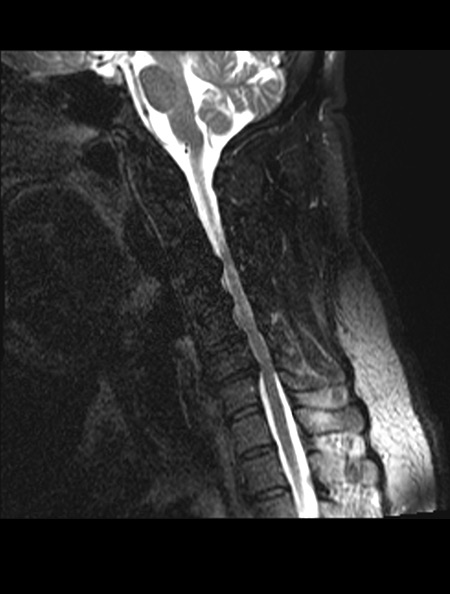
Tom's story
4-level ACDF
Spinal stenosis had been part of Tom's family history for decades. Both his mother and father had experienced the degenerative condition that leads to a painful narrowing of the spinal nerve root canals and an enlargement of facet joints in the spine. But it was a heavy snowfall that finally brought that family history into the present.
"I wasn't experiencing any signs or symptoms prior to January 2019," Tom says. "After a large snowfall I was out shoveling snow, and about one or two days afterwards, I started having severe neck pain and pain in the shoulder blades. I thought maybe I had aggravated some muscles."
The pain continued, and about a week later Tom began experiencing severe numbness and tingling in his left arm and forefinger. It felt similar to what he had experienced on his right side after damaging his right rotator cuff. Tom, a registered nurse and health care administrator whose work requires travel, was suffering, and he knew he needed to see a doctor. He scheduled an appointment with his orthopedic surgeon, who ordered x-rays. The rotator cuff, it turned out, was fine.
With Tom seated in the examination room, the orthopedist asked him to look up toward the corner of the ceiling. "I tried," Tom recalls, "but I couldn't get my neck turned enough to look up without severe pain."
The orthopedist sent Tom for an MRI and, the same day, referred him "right away" to Michael Kachmann, MD, a neurosurgeon with Mayfield Brain & Spine. The stenosis in Tom's cervical spine was serious, causing spinal compression at four levels. A week later, Tom arrived at Dr. Kachmann's office. By this time, he was feeling numbness and tingling in his right leg.
Tom first saw Jody Miniard, DNP, a Mayfield nurse practitioner. She reviewed his scans and explained how and why the stenosis was causing his progressing symptoms. When Tom told her that he didn't want to live on narcotics or muscle relaxers for the rest of his life, Ms. Miniard smiled. "That's good, because we wouldn't let you," she said. "I'm going to go get Dr. Kachmann now, because you and he will need to discuss surgery."
"That was kind of shocking, because I thought maybe they'd have me try physical therapy," Tom says. "But Dr. Kachmann said physical therapy or injections would be temporary and would not do anything to fix my problem."
Tom was scheduled for surgery a month later at The Jewish Hospital – Mercy Health. During the weeks prior, he took gabapentin, a medication that eased his nerve pain.

Tom's MRI shows his spinal cord resembling a string of pearls. It is being pinched by bone spurs and bulging discs from the front and thickened ligaments from the back.

After fusion to 4 levels of his neck, the nerves and spinal cord are decompressed and the space between the bones restored.
In early April 2019, over a period of about 90 minutes, Dr. Kachmann performed a four-level anterior cervical discectomy and fusion (ACDF). He made an incision in the front of Tom's neck, reaching the damaged discs by moving aside the neck muscles, trachea, and esophagus. By operating from the front of the neck, Dr. Kachmann avoided disturbing Tom's spinal cord, spinal nerves, and strong neck muscles.
After removing the discs, Dr. Kachmann inserted spacers filled with cadaver bone grafts and fixed them in place with metal plates and screws. Over the next several months, new bone cells would grow around the grafts, eventually joining together in solid pieces of bone.
"Tom had severe degenerative changes of the cervical spine, causing not only his neck pain but also compression of the spinal cord, which is very concerning," Dr. Kachmann says. "We like to take care of compression of the spinal cord before it is a problem. Once the cord is damaged, I cannot make it better, so we like to treat people early in the myelopathy course.
"His surgery is a common surgery, and our technique is efficient. We get in and get out in a time frame that avoids swelling and bleeding. He did very well from surgery, as most people do."
Tom felt better immediately after surgery. "When I came out of anesthesia, all the pain in my neck and back was gone," Tom says. "The numbness was still there, which was expected. It may or may not ever go away; it depends on how much damage was done to the spinal nerves before the surgery. Still, it is 100 percent better and continues to improve. The numbness is definitely not as noticeable."
Tom's surgery was on a Friday. He spent two nights in the hospital and was discharged on Sunday. By Monday, he was taking only Tylenol for surgical pain. By Tuesday, he was working from home. He was unable to drive, of course, and he was required to wear a neck brace because of the extensive fusion.
For others who face multiple-level cervical fusions, Tom offers these insights. "I would go see Dr. Kachmann," he says. "He is very confident in his abilities, and his bedside manner and compassion for his patient are the best I've ever seen in a physician. He can relate to you, and you can relate to him. He explains everything, and he makes sure you have his personal phone number. If you have any problems or concerns, you can call him."
Hope Story Disclaimer -"Tom's Story" is about one patient's health-care experience. Please bear in mind that because every patient is unique, individual patients may respond to treatment in different ways. Results are influenced by many factors and may vary from patient to patient.

